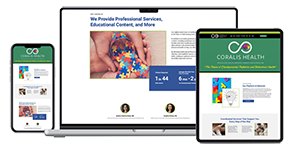If your child’s healthcare provider has recommended medication as part of treatment for ADHD, this article will share with you the things you need to know.
Medication For ADHD Does Not Work In Isolation
When starting ADHD medications it is important to consider the child’s age, weight, medical history, and the best way for the child to take the medication (liquid, chewable pill, or pill that they can swallow), as well as goals and expectations.
It is important to understand that, while medication can be an essential part of ADHD management, it does not work in isolation, but rather as part of a comprehensive symptom management strategy. Other important factors to consider include lifestyle modifications, eating a healthy diet, maintaining good sleep hygiene, adequate support at school, and counseling.
 How Do ADHD Medications Work?
How Do ADHD Medications Work?
One of the first questions many parents ask is, how do ADHD medications actually work? With ADHD, brain chemicals also known as neurotransmitters, primarily dopamine and norepinephrine, are not efficiently released into the areas of the brain that help us manage executive functioning, impulse control, activity levels, and emotional regulation. ADHD medications work by helping these chemicals go where they need to, kind of like traffic control, allowing for brain signals to transmit more effectively.
When treating ADHD with medication there are two options – stimulants and non-stimulants. Stimulant medications are the traditional medications that come to mind when we think about ADHD medication. They include the more well-known medications like Ritalin and Adderall. These are usually the first line medications, because they are the most effective in targeting both inattention and hyperactivity/impulsivity.
ADHD Stimulant Medication Options
With stimulant medications there are two main classes:
Methylphenidate-based medications: These include brands like Ritalin, Concerta, and Daytrana. They work by increasing the levels of dopamine and norepinephrine in the brain, which helps improve attention, activity levels, impulse control, and emotional dysregulation.
Amphetamine-based medications: These include brands like Adderall, Vyvanse, and Dexedrine. They also increase dopamine and norepinephrine levels in the brain, but they do so in a slightly different way compared to methylphenidate-based medications. They also help improve attention, activity levels, impulse control, and emotional dysregulation.
Both classes are effective in managing ADHD symptoms, but individuals may respond differently to each type, so it often involves some trial and error to find the most effective medication and dosage.
For stimulant medications, there are both short-acting versions, lasting between 3-4 hours, and long-acting versions, lasting between 6-12 hours. The best type to use really depends on how long the medication needs to last, keeping in mind age, appetite, and sleep considerations.
Stimulant medications do not need much time to take effect – usually within 30 minutes to an hour. These medications stay at therapeutic levels for hours, not days. The good thing about this is that if there are negative effects noted, you don’t give another dose and it is usually out of the child’s system within the same day.
Common side effects with these medications include decreased appetite, which can lead to weight loss if not monitored, upset stomach and headaches, especially when taken without eating a meal or not drinking enough water, increased heart rate, irritability, and difficulty with sleep, if given too late in the day.
In general, children are started on a low dose and if no side effects are noted, the dosage can be increased as needed to get maximum benefit.

ADHD Non-Stimulant Medication Options
The second type of ADHD medications are non-stimulants. These are a newer type of medication compared to stimulants. They can be helpful if stimulants have not been effective, or if stimulants are not an option due to low weight concerns, or for younger children. They can also work well in combination with stimulant medications, as they generally last longer and can have fewer side effects.
As with stimulant medications, there are two main classes of non-stimulants:
Alpha-Agonists: These include Guanfacine and Clonidine. These medications help with hyperactivity, impulsivity, and emotional dysregulation. Both can make children tired when starting, especially Clonidine, so it is typically not used as often as Guanfacine. These usually do not negatively affect appetite or sleep, which is also a plus.
Selective Norepinephrine Reuptake Inhibitors (SNRIs): These include Atomoxetine (Strattera) and Viloxazine (Qelbree). These are, in theory, supposed to help with both ADHD and anxiety. However, they are still not first line options, but good to consider when stimulants don’t work well for a child. SNRIs can affect appetite.
Non-stimulants do need to be given every day to work best. They also need more time to build up to therapeutic levels (which may take weeks), as compared to stimulant medications. Parents need to factor in this delay with symptom management expectations.
 Finding The Right Medication Can Be Life Changing
Finding The Right Medication Can Be Life Changing
When it comes to treating ADHD, we at Coralis Health love working with these kids, and are passionate about finding the best combination of strategies to help them.
Just as eye glasses would not be withheld from a child that needs them, so too should ADHD medication be given the same consideration, if necessary, as part of a comprehensive symptom management strategy.
It is so rewarding to pair the right medication with the right support, and then seeing how successful these children become, not only in their school performance, but also with their home life and self-confidence. Many times parents share how they wish they would have started medication sooner.
If you have any additional questions on medications for ADHD, or to discuss what would be the best options for ADHD management for your child, please reach out to us. We are always hear to help!



